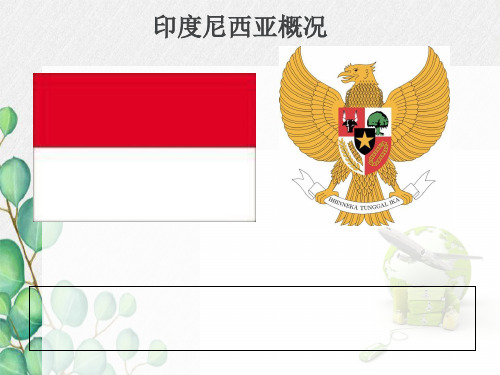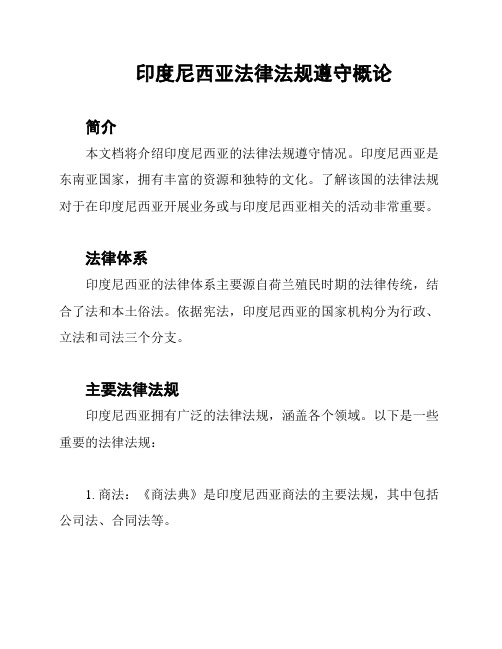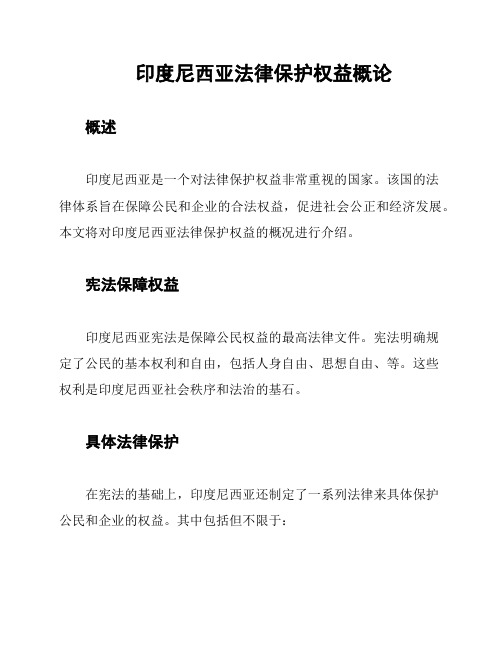印度尼西亚环境保护管理简介
印尼中苏拉威西环评报告

印尼中苏拉威西环评报告据印尼当地媒体报道,印尼环境与林业部(KLHK)证实,苏拉威西东南部Kolaka Regency的镍矿开采符合环境管理体系。
公共关系(Humas)负责人Nunu Anugrah表示,管理东南苏拉威西岛镍矿的公司PT Ceria Nugraha Indotama(CNI)是一家在2019年和2020年持有Blue Proper的公司。
据悉,《Blue Proper》由印度尼西亚共和国环境和林业部长2014年第3号条例规定,该条例涉及公司在环境管理方面的绩效评级计划。
Nunu Anugrah表示,基于2019年和2020年的正确评估,PT CNI获得了Blue Proper。
同时,对2021年的评估仍在进行中,其确定是在2021年7月参照共和国环境和林业部长的规定进行的印度尼西亚2021年第1号关于公司绩效评估计划在环境管理方面的报告。
他表示,根据部级法规,《公司环境管理绩效评估计划》是对环境管理部门业务和/或活动负责人的绩效的评估。
正确的向在环境管理方面表现出色的商业世界致敬。
通过评估遵守环境法规,执行环境管理系统,能源效率,节水,减排,生物多样性保护,B3和固体废物,非B3和社区赋权的过程,尊重商业世界。
同时,环境和林业部污染控制总干事卡连雅(Karliansyah)表示,评估还包括对土地损害的控制,其中包括有系统的努力,包括预防,减轻和恢复由采矿造成的土地损害。
“这包括环境影响分析(阿姆达尔),环境管理工作以及环境监测和环境管理工作(以下简称RLK / RPL),中央政府或地方政府颁发的环境批准书以及以评估形式进行的环境审计负责评估业务和/或活动负责人对政府制定的法律要求和政策的依从性。
”但是,Karliansyah透露了适当的评分可以根据公司的能力或不遵守环境法规每年进行更改(根据相关活动的废水质量标准和排放质量标准处理废水及其排放,还根据适用的标准管理LB3)他表示:“对于采矿活动以及潜在的环境破坏,如果满足所有要求,公司将获得BLUE等级,但如果不满足,则肯定会获得RED等级。
2023年印度尼西亚排放标准

2023年印度尼西亚排放标准:深度评估及影响分析一、引言2023年印度尼西亚排放标准,作为一个关乎环保、经济和社会发展的重要议题,备受关注。
本文将从深度和广度的角度对这一主题进行全面评估,探讨其影响及未来发展趋势。
二、印度尼西亚排放标准的背景与重要性2023年印度尼西亚排放标准,是印度尼西亚政府为迎接经济和环境挑战而进行的重要改革举措。
随着工业化进程的加快和汽车保有量的增加,印度尼西亚的环境污染问题日益突出,尤其是大气污染已成为困扰人们生活的主要问题。
为了应对这一问题,印度尼西亚政府不得不制定更为严格的排放标准,以减少污染物排放,改善环境质量。
印度尼西亚排放标准的实施对于环保、社会和经济带来了重要影响。
严格的排放标准有助于改善空气质量,减少环境污染对人们身体健康的影响,提高居民生活质量。
对汽车和工业等领域的排放标准的提高,将促使企业进行技术升级和产品创新,有助于推动技术和产业的升级,提高经济发展的质量和效益。
2023年印度尼西亚排放标准的实施对于实现环境保护和经济可持续发展具有重要意义。
三、2023年印度尼西亚排放标准的主要内容2023年印度尼西亚排放标准主要包括对车辆和工业排放的要求。
在车辆排放方面,标准主要包括对汽车尾气排放的限制,例如对二氧化碳、一氧化碳和氮氧化物排放的限制,并规定了车辆尾气排放的检测方法和技术要求。
在工业排放方面,除了对污染物排放的限制外,还对工业企业的治理和监管进行了规范,以确保企业排放符合国家标准。
值得一提的是,印度尼西亚政府在制定2023年排放标准时,充分考虑了国内外先进经验和技术,以确保标准的科学性和前瞻性。
政府还对标准的实施进行了严格的计划和监督,以确保标准的顺利实施和执行。
四、2023年印度尼西亚排放标准对此前标准的改进和影响相比于此前的排放标准,2023年印度尼西亚排放标准在以下几个方面进行了重要改进。
对污染物种类和排放限值进行了扩大和提高,覆盖了更多的污染物种类,并提出了更为严格的排放限值。
印度尼西亚概况--简介

——印度尼西亚的经济环境——
2.经济基础设施
从1965年以来,政府以每年政府支出的15%作为交通基础设施建设的 投资,为印尼经济的快速增长提供了重要保障。
⊙交通基础设施
公路和水路是重要的运输手段,其中公路担负着国内近90%的客运和 50%的货运。
——印度尼西亚的经济环境——
2.经济基础设施
全国有水运航道21579公里,各类港口672个,主要港口有雅加达的丹 绒不禄港,泗水的丹绒佩拉港和棉兰的勿老港。
——印度尼西亚的经济环境——
5.外资和外援
近几年,外商投资最集中的领域依次位是制造业和服务业,主要集中 到运输、仓储、通讯、化学和制药工业、造纸和印刷工业、建筑业、 非金属矿等行业。
外资最集中的地区依次是:经济发达的西爪哇、首都雅加达特区、苏 门答腊、东爪哇等4个地区。
近年来,中国已成为印尼的重要经济合作伙伴。
印度尼西亚概况
提纲
自然环境
政治环境
经济环境
文化环境
习俗与禁忌
常见疾病与医疗状况
交通与出行
工程相关法律法规
——印度尼西亚——
印度尼西亚共合国(The Republic of Indonesia )
印度尼西亚是东南亚最大的岛国,也是世界上最大的群岛国 家,总人口达2.2亿人,拥有巨大的市场潜力。
对用于生产出口产品而进口的货物可退进口税,对于在国内购买 用于生产出口产品的物资免增价税,企业可自由选择在国内或国 外购买生产所需要的原料。
——工程相关法律法规 ——
3.投资法
印尼涉及外国投资方面的法律目前是2005年颁布的第25号《投 资法》,规范了国内外投资。
第一,如土地使用权,由原来的35年延长到95年,建筑使用权 由原来的50年延长到80年,而由地方政府批准的土地使用权最长 可达70年。
印尼青美邦的规章制度和管理要求

印尼青美邦的规章制度和管理要求1.法律和法规:印尼青美邦的规章制度主要基于中央政府的法律和法规,如印度尼西亚共和国主权宪法。
此外,根据印度尼西亚法律,青美邦拥有一定的自治权,可以制定适合本地区的规章制度。
2.政府组织:印尼青美邦的政府由地方行政机构和地方议会组成。
地方行政机构负责管理青美邦的日常事务,包括财政、城市规划、土地使用等。
地方议会则负责监督地方政府的行为,并参与决策过程。
3.土地使用规划:印尼青美邦有一套土地使用规划制度,旨在合理规划土地的开发和利用。
该制度由地方政府负责执行,以确保土地使用符合规定和法律,保护环境和自然资源。
4.工业和商业管理:印尼青美邦对工业和商业活动有一套严格的管理要求。
企业必须遵守相关法律法规,如环境保护法、劳动法等。
此外,企业还需获得必要的许可证和证书,包括工业许可证、商业许可证等。
5.教育管理:印尼青美邦的教育管理要求包括确保教育机构的合法性和质量。
教育机构需要获得相关的许可证和认证,以确保其具备一定的教育水平和标准。
此外,青美邦政府还制定了教育政策,以确保教育资源的合理分配和公平机会。
6.公共安全和警察管理:印尼青美邦有一套完善的公共安全管理系统,包括警察和消防等部门的职责。
警察负责维持社会治安和执法,消防部门负责预防和应对火灾和其他紧急情况。
7.社区参与和民主决策:印尼青美邦鼓励社区居民参与地方事务的决策过程。
地方政府会组织社区会议和公众听证会等形式的民主决策机制,听取民众的意见和建议。
这种参与机制有助于保持政府的透明度和公正性。
总结:印尼青美邦有一套相对完善的规章制度和管理要求。
这些制度和要求旨在确保社会、经济和环境的可持续发展,同时保护公民的权益和利益。
地方政府负责执行这些制度和要求,并与公民一起参与决策过程,以确保管理的公正性和有效性。
印度尼西亚法律法规遵守概论

印度尼西亚法律法规遵守概论简介本文档将介绍印度尼西亚的法律法规遵守情况。
印度尼西亚是东南亚国家,拥有丰富的资源和独特的文化。
了解该国的法律法规对于在印度尼西亚开展业务或与印度尼西亚相关的活动非常重要。
法律体系印度尼西亚的法律体系主要源自荷兰殖民时期的法律传统,结合了法和本土俗法。
依据宪法,印度尼西亚的国家机构分为行政、立法和司法三个分支。
主要法律法规印度尼西亚拥有广泛的法律法规,涵盖各个领域。
以下是一些重要的法律法规:1. 商法:《商法典》是印度尼西亚商法的主要法规,其中包括公司法、合同法等。
2. 劳动法:《劳动法典》规定了雇佣关系、工资和劳动者权益等相关法律规定。
3. 知识产权法:印度尼西亚的知识产权法包括专利、商标和版权等方面的相关法规。
4. 环境法:《环境管理法》等法规旨在保护印度尼西亚的环境资源。
法律法规遵守在印度尼西亚开展业务或与印度尼西亚相关的活动,法律法规遵守是非常重要的。
以下是一些遵守法律法规的建议和策略:1. 了解法律法规:详细了解与自己业务相关的法律法规,并及时更新变化。
2. 合规管理:建立合规部门或委员会,确保公司内部的业务和行为符合法律法规要求。
3. 培训和教育:提供培训和教育,使员工了解并遵守相关法律法规。
4. 合作伙伴审查:审查合作伙伴的合规情况,在选择合作伙伴时考虑其法律法规遵守能力。
5. 法律咨询:寻求专业的法律咨询,在重大决策和合同签订前获取法律意见。
总结印度尼西亚的法律法规丰富多样,遵守法律法规对于在该国开展业务至关重要。
通过了解相关法律法规,建立合规机制,并获得专业法律咨询,可以有效降低法律风险,确保业务活动的合法性与可持续性。
印尼海洋资源管理制度

印尼海洋资源管理制度引言印尼是一个拥有众多海洋资源的国家,拥有丰富的渔业、矿产和能源资源。
为了保护和有效管理这些海洋资源,印尼制定了一系列的海洋资源管理制度。
本文将对印尼海洋资源管理制度进行深入探讨,包括其法律法规、管理机构、策略和措施等内容。
法律法规印尼海洋资源管理制度的基础是一系列的法律法规。
其中最重要的法律是《印度尼西亚海洋法》(Indonesian Maritime Law),该法于2000年通过,为印尼海洋资源的管理和保护提供了法律依据。
此外,还有诸多与海洋相关的法律和法规,包括《印度尼西亚渔业法》(Indonesian Fisheries Law)和《印度尼西亚海洋保护区法》(Indonesian Marine Protected Areas Law)等。
管理机构印尼海洋资源管理制度涉及多个管理机构的协作和监督。
其中最重要的机构是印尼海洋与渔业事务部(Ministry of Maritime and Fisheries Affairs),该机构负责协调和监督海洋资源管理工作。
此外,还有业务和地方性政府机构,如印尼渔业与海洋研究所(Indonesian Agency for Fisheries Research and Development)和印尼海洋和渔业管理局(Indonesian Agency for Marine and Fisheries Management)等。
策略和措施为有效管理印尼的海洋资源,印尼采取了一系列的策略和措施。
其中包括以下几个方面:渔业管理印尼通过制定渔业管理计划和政策,推动可持续渔业发展。
其中包括限制捕鱼数量和尺寸、设立渔业保护区、推广渔业科学技术、加强监测和执法等。
此外,印尼还与其他国家和国际组织合作,开展渔业资源管理和执法交流。
海洋保护区印尼设立了一系列的海洋保护区(Marine Protected Areas),以保护珊瑚礁、鱼类和其他海洋生物的生态系统。
印度尼西亚火力发电厂排放标准

印度尼西亚火力发电厂排放标准印度尼西亚作为一个发展中国家,能源需求不断增长。
火力发电厂作为主要的能源供应来源之一,对环境产生了重要影响。
因此,制定和执行严格的排放标准对于保护环境和人民的健康至关重要。
火力发电厂排放标准是指对于燃烧过程中产生的废气、废水和固体废弃物的排放进行限制和监管的规定。
这些排放物中包括二氧化硫、氮氧化物、颗粒物等有害物质,它们对大气、水体和土壤造成污染,对人体健康产生危害。
印度尼西亚政府已经意识到了火力发电厂排放对环境和人民健康的威胁,并采取了一系列措施来改善这一状况。
首先,政府制定了严格的法律法规,对火力发电厂的排放进行了限制。
这些法律法规包括《环境保护法》、《大气污染防治法》等,明确了火力发电厂应当达到的排放标准和相应的处罚措施。
其次,政府加强了对火力发电厂的监管和执法力度。
相关部门对火力发电厂进行定期检查,确保其排放符合标准。
对于违反排放标准的火力发电厂,政府将采取严厉的处罚措施,包括罚款、停产整顿等,以确保其改善排放状况。
此外,政府还鼓励火力发电厂采用清洁能源技术,减少对环境的污染。
例如,引入先进的燃烧技术和烟气脱硫、脱硝等治理设备,可以有效降低二氧化硫和氮氧化物的排放。
同时,政府还鼓励火力发电厂使用可再生能源,如太阳能和风能,以减少对化石燃料的依赖。
此外,政府还加强了对火力发电厂的环境影响评估。
在火力发电厂建设前,必须进行环境影响评估,评估其对周边环境的影响,并提出相应的环境保护措施。
这有助于预防和减少火力发电厂对环境的负面影响。
然而,尽管政府已经采取了一系列措施来改善火力发电厂的排放状况,但仍然存在一些挑战。
首先,一些火力发电厂可能缺乏资金和技术支持,无法进行必要的污染治理设施的安装和更新。
其次,监管和执法力度仍然不够强大,一些火力发电厂可能存在违规排放的情况。
最后,火力发电厂的建设和运营可能对当地社区和生态环境产生负面影响,需要更加注重社会责任和可持续发展。
综上所述,印度尼西亚火力发电厂排放标准的制定和执行对于保护环境和人民健康至关重要。
印度尼西亚法律保护权益概论

印度尼西亚法律保护权益概论概述印度尼西亚是一个对法律保护权益非常重视的国家。
该国的法律体系旨在保障公民和企业的合法权益,促进社会公正和经济发展。
本文将对印度尼西亚法律保护权益的概况进行介绍。
宪法保障权益印度尼西亚宪法是保障公民权益的最高法律文件。
宪法明确规定了公民的基本权利和自由,包括人身自由、思想自由、等。
这些权利是印度尼西亚社会秩序和法治的基石。
具体法律保护在宪法的基础上,印度尼西亚还制定了一系列法律来具体保护公民和企业的权益。
其中包括但不限于:1. 劳动法:保护劳动者的权益,规定了雇佣关系、劳动合同、工作条件、劳动报酬等方面的规定。
2. 消费者保护法:保护消费者的合法权益,规定了商品和服务的质量标准、消费者维权机构等方面的规定。
3. 知识产权法:保护知识产权,包括专利、商标、著作权等方面的保护。
4. 环境保护法:保护环境和自然资源,规定了环境质量标准、环境权益保护措施等。
司法保护机制印度尼西亚拥有独立的司法体系来保障权益的执行和维护。
法院是负责审理和裁决案件的机构,公正地处理涉及权益纠纷的案件。
其中,最高法院是该国最高级的法律机构。
除了司法机构外,印度尼西亚还设立了多个独立机构来保护公民和企业的权益,例如人权委员会、反垄断委员会等。
国际合作为了更好地保护权益,印度尼西亚也积极参与国际社会的合作。
该国是许多国际组织和条约的成员,致力于推动全球范围内的权益保护。
同时,印度尼西亚也与其他国家签订了双边法律合作协议,加强了国际合作的力度。
总结印度尼西亚法律保护权益的概论可以总结为:有宪法保障、具体法律保护、司法保护机制和国际合作。
这些机制保证了公民和企业的合法权益得到有效的保护和维护,为社会稳定与经济发展提供了坚实的基础。
印尼海洋资源管理制度概述

印尼海洋资源管理制度概述印尼拥有丰富的海洋资源,包括渔业资源、石油和天然气等能源资源、海底矿产资源以及旅游资源等。
为了有效管理和保护这些宝贵的海洋资源,印尼建立了一套完善的海洋资源管理制度。
本文将对印尼海洋资源管理制度进行概述,并分享我的观点和理解。
【1】海洋资源管理的法律框架印尼的海洋资源管理制度建立在一系列的法律框架上。
其中最重要的是《印度尼西亚宪法》和《印度尼西亚渔业法》。
《印度尼西亚宪法》将印尼的海洋作为国家财产,强调了国家对海洋资源的拥有权和保护责任。
《印度尼西亚渔业法》则规定了渔业资源的管理、保护和可持续利用的原则和措施。
还有许多法律法规和政策文件,如国家海洋空间规划、海洋环境保护法等,为海洋资源管理提供了具体的指导。
【2】海洋资源管理的机构和责任印尼设立了多个机构来管理海洋资源。
其中最重要的是印尼渔业与海洋事务部(Ministry of Marine Affairs and Fisheries,简称MMAF)。
MMAF是负责制定和执行海洋资源管理政策的主要机构,在保护渔业资源、管理海洋保护区、推进可持续渔业发展等方面发挥着重要作用。
还有其他政府机构、地方政府和非政府组织参与海洋资源管理工作,形成了多方合作、协同推进的管理体系。
【3】渔业资源管理渔业是印尼海洋资源管理的重要组成部分。
为了维护渔业资源的可持续利用,印尼采取了多种管理措施。
其中包括渔业配额制度、禁捕期、禁渔区设立等。
印尼还加强了渔业监管和执法力度,打击非法捕捞和破坏海洋生态的行为。
通过这些措施,印尼致力于保护渔业资源,维护渔民的利益,推动可持续渔业发展。
【4】海洋保护区管理为了保护海洋生态系统和物种多样性,印尼建立了一系列海洋保护区。
这些保护区包括海洋自然保护区、海岛自然保护区、海草床保护区等。
印尼通过设立保护区划定了特定海域的保护边界,限制了商业捕捞和其他破坏性活动,保护了海洋生物栖息地和珍稀物种。
印尼也加强了保护区的管理和监测,确保其有效发挥保护作用。
印度尼西亚环保措施

印度尼西亚环保措施印度尼西亚是一个以自然环境为主要资源的国家,但由于工业化的加快和人口增长,其环境问题已经成为了一件难以回避的问题。
为了改善和保护自然环境,印度尼西亚政府制定了一系列的环保措施。
国家法规制度为了保护环境,印度尼西亚政府制定了一系列环境保护法律,其中最重要的是《环境管理法》。
该法律规定了污染物排放的标准和环境保护的要求,对环境犯罪者进行处罚。
此外,印度尼西亚还颁布了其他相关法律,如《自然资源保护法》、《森林保护法》等。
环境监测与污染治理印度尼西亚政府设立了环境监测系统,建立了定期的环境报告制度。
政府还致力于治理环境污染,建设了若干废水处理厂、垃圾填埋场等环保设施。
此外,印度尼西亚在城市地区启动了一项名为“清洁城市计划”的行动,这是一项全面的城市环境改善计划,旨在解决城市环境中存在的问题。
绿色能源和可再生能源由于印度尼西亚是一个高度依赖化石燃料的国家,为了减少对环境的影响,印度尼西亚政府着眼于开发绿色能源和可再生能源。
政府建立了法规和政策,鼓励私人和公共机构使用太阳能、风能、水能等可再生能源。
生态旅游印度尼西亚的自然环境得天独厚,政府致力于保护这些自然资源并鼓励发展生态旅游业。
政府加强对旅游业的规范,限制对敏感自然环境的影响。
政府还建设和维护生态旅游基础设施和保护设施等。
人口控制印度尼西亚是世界上人口增长最快的国家之一,为了缓解人口对环境造成的负面影响,印度尼西亚改革人口政策,推广计划生育,并且通过宣传普及教育和改善女性的地位和社会利益来推动人口控制。
总结印度尼西亚政府正在采取一系列的环保措施,以保护自然环境和人类健康。
但问题仍然存在,如物质浪费、生态破坏等问题,需要全社会的努力和行动,只有共同努力才能达到环境保护的目标。
印度尼西亚土地沙化问题加剧生态平衡面临威胁

印度尼西亚土地沙化问题加剧生态平衡面临威胁印度尼西亚,作为东南亚最大的岛国之一,拥有丰富的自然资源和生态环境。
然而,近年来,印度尼西亚土地沙化问题逐渐凸显,给当地的生态平衡带来了严重的威胁。
本文将就印度尼西亚土地沙化问题的原因、影响及应对措施展开探讨。
土地沙化指的是土地表面的土壤逐渐变为沙质或沙漠化的过程。
印度尼西亚土地沙化的主要原因可以归结为人类活动和气候变化两个方面。
首先,人类活动是导致印度尼西亚土地沙化问题加剧的主要原因之一。
随着人口的增长和经济的发展,印度尼西亚的土地利用方式发生了巨大变化。
大量的森林被砍伐用于农业、工业和都市化等目的,导致了大面积的土地暴露在自然条件下。
同时,过度的牧畜活动也对土地造成了很大的负担。
这些人类活动加速了土壤的脆化,使其更容易受到水、风和水土流失等自然因素的侵蚀。
其次,气候变化也对印度尼西亚的土地沙化产生了重要影响。
气候变暖导致干旱现象的加剧,进而导致土壤水分的流失和土地的干燥。
此外,频繁的极端天气事件如洪水、干旱等也会加剧土壤的脆弱性,使其更容易受到外界环境的破坏。
印度尼西亚土地沙化问题对生态平衡造成了严重威胁。
首先,土地沙化导致了植被的丧失和栖息地的破坏,对野生动植物种群的生存和繁衍造成了极大的影响。
其次,土地沙化会削弱土壤的生产力,对农业生产和粮食安全构成威胁。
此外,土地沙化会导致水土流失加剧,进而造成水资源的损失和局部水源的枯竭。
为了解决印度尼西亚土地沙化问题,应采取一系列应对措施。
首先,加强土地保护和自然资源管理工作,实施严格的土地使用政策和限制性开发规范,避免过度利用土地资源。
其次,推动可持续农业发展,采取适当的农耕措施和土壤改良技术,提高土壤的保水能力和养分含量,从而减少土壤沙化风险。
此外,应加强对水资源的管理和保护,推动水土保持工程,减少水土流失的发生。
最后,加强气候变化应对和适应能力,减轻极端天气事件对土壤的破坏程度。
综上所述,印度尼西亚土地沙化问题的加剧对生态平衡构成了严重威胁。
印度尼西亚简介介绍

未来合作前景和展望
深化政治互信
双方将继续保持高层交往,加强战略沟通,增进政治互信 ,为两国关系的持续发展提供坚实政治基础。
促进人文交流
双方将继续加强在教育、文化、旅游等领域的人文交流, 进一步拉近两国人民的心灵距离。
拓展经济合作
在共建“一带一路”框架下,双方将进一步加强在基础设 施、产能、投资等领域的合作,推动两国经贸关系向更高 水平、更广领域迈进。
• 石油和天然气:印度尼西亚拥有丰富 的石油和天然气资源,这些产业在国 内生产总值中占有重要地位。
国际贸易和投资
01
02
03
贸易伙伴
中国、日本、美国等是印 度尼西亚的主要贸易伙伴 ,与其保持着紧密的经贸 关系。
外商投资
印度尼西亚政府鼓励外商 投资,提供一系列优惠政 策和措施,吸引外国投资 者进入国内市场。
文化交流和民间交往
文化交流
印度尼西亚和中国都有着悠久的历史和灿烂的文化,两国在文化领域的交流与合作日益活跃。双方互 办文化年、艺术节等活动,促进了彼此文化的传播与交融。
民间交往
随着两国关系的发展,印度尼西亚和中国的民间交往也日益频繁。旅游、教育、科技等领域的交流与 合作不断增多,加深了两国人民之间的友谊。
和大洋洲两大洲。
纬度和经度
印度尼西亚位于赤道附近,纬度范 围在10°S至10°N之间,经度范围 在95°E至140°E之间。
海域和邻国
印度尼西亚拥有广阔的海域,与巴 布亚新几内亚、东帝汶、马来西亚 、菲律宾、澳大利亚等国接壤或通 过海峡相隔。
人口和民族
人口数量
印度尼西亚是世界上第四大人口 国家,人口数量约为2.7亿。
旅游设施改善
政府持续投资于旅游基础设施的改善,包括机场 、道路、港口等,以提高游客的旅行体验和便利 性。
浅析印度尼西亚《环境管理法》及其借鉴意义

1 .综合 性 的立法 框架
《 环境管理法》共含 1 1 章 。第一章 、 第二章为总
则 性 的规定 ; 第三 章 “ 社 区 的权 利 、 义 务 和任 务 ” , 对 公 民和社 区 的权 利 和义 务进 行 了规 定 , 为 使 社 区更 好 地
VO1 . 9 NO. 1 J a n. 2 0 1 3
浅析 印度尼西亚《 环境管理法》 及其借鉴意义
赵 紫 涵
( 中国政法 大学 民商经济 法 学院 , 北京 1 0 0 0 8 8 )
摘 要: 1 9 9 7年颁布的《 印度尼西亚共和国环境管理法》 在 国家责任原 则、 可持 续原则 、 开发 原则和谨慎 原 则的 基础上 ,
达成协 议 的进行 庭上 审理 , 规定 了严 格责任 原则 、 免 责 事 由、 诉 讼 时 效 及 社 区诉 讼 和 政 府 行 动 ; 第 八 章 关 于
“ 环境 调查 ” 。不 同于 刑事 犯 罪 的调 查 , 负 有 环境 管 理
法律 体 系将 有 助于 改 变 不利 的情 况 , 遏 制 环境 的持 续 污染 和破 坏 。受 2 0世纪 7 0年 代 以来 确立 的可 持续 发 展原 则影 响 , 一部适 应 国情 和 时代 发展 需 要 的 环境 法
设立 了一 系列如排 污许 可证制度 、 污染者 负担制度、 公 民参与知情制度 、 环境影响评 价制度等较为先进 的制度 , 在 纠纷 解
决方 面确立 了社 区共 同诉讼 、 政府行动、 环境组 织的公益诉讼 等诉讼形 式。我 国和印尼 的国情不 同, 所 面I 临的环 境 问题
也各有特 点, 但是 两国都试 图通过立 法来解决环境 问题 , 因此 , 印尼 的环境管理 法会 对我 国的环境立 法提 供 一定的借 鉴
环境保护的风险管理

环境保护的风险管理一、引言环境保护是当今社会发展的重要议题之一。
随着工业化和城市化的快速发展,环境问题日益严重,给人类生存和可持续发展带来了巨大的风险。
因此,进行环境保护的风险管理至关重要。
本文将详细介绍环境保护的风险管理,并提供一些数据和案例以支持我们的观点。
二、环境保护的风险1. 自然灾害风险自然灾害是环境保护中的一个重要风险因素。
例如,地震、洪水、飓风等自然灾害会对环境造成严重破坏,对生态系统和人类社会造成巨大影响。
因此,我们需要制定相应的应急预案和灾后恢复计划,以减轻自然灾害对环境的影响。
2. 污染风险污染是环境保护中的另一个重要风险因素。
工业生产、交通运输、农业活动等都会产生大量的污染物,如废气、废水、固体废弃物等。
这些污染物会对空气、水和土壤造成污染,危害生态系统和人类健康。
因此,我们需要采取措施来减少污染物的排放,加强污染管理和监测。
3. 生物多样性丧失风险生物多样性是地球生态系统的重要组成部份,对维持生态平衡和人类社会的可持续发展至关重要。
然而,由于人类活动的不当干扰,许多物种正面临灭绝的风险。
因此,我们需要保护自然生态系统,采取措施保护和恢复生物多样性。
三、环境保护的风险管理措施1. 风险评估风险评估是环境保护的第一步。
通过对环境风险进行评估,我们可以确定哪些风险是最重要的,以及它们对人类和生态系统的影响程度。
在评估过程中,我们需要采集和分析大量的数据,包括环境监测数据、气象数据、地质数据等。
2. 风险预警和监测风险预警和监测是环境保护的重要手段。
通过建立风险预警系统,我们可以及时发现环境风险的迹象,并采取相应的措施来减轻其影响。
同时,我们还需要建立环境监测系统,对环境质量进行实时监测和评估。
3. 风险应急管理风险应急管理是环境保护的关键环节。
当环境风险发生时,我们需要迅速采取措施来应对和控制风险。
这包括组织人员进行救援和灾后恢复工作,提供紧急救援物资和设备,以及与相关部门和机构进行协调和合作。
印度尼西亚与中国合作可持续性地管理木材资源

友好的经济活动 ,其一为社区林业计划 ,社区可向 国家租用土地 发展林 业 ,此计划将有力地促 进林 业 的发展 。 ( 管 宁)
另外 , 谢金汉补充道 , W 还致力于将木材生 MG 产商、贸易商 以及买家紧密的联合起来 。在 MT C和 各个主要的木材协会 , 例如美 国阔叶木外销委员会 、
林业 、野生动植物保护合作和动植物群的持续利用 等 。中国森林面积居世界第五 ,总面积 1 5 k 。 2万 m, 相当于 印尼国土总面积的 7 %。中国正在推动环境 5
官谢金汉表示 ,现在正 是在 东南亚地 区举行 MGW 这 种展 会的大好 时机 。马来西亚本 身也是一个木材
的主要进 口国 , 0 9 2 0 年从美 国、巴西、印度尼西亚、 澳大利亚 、新西 兰、加纳 以及其它 国家进 I的木材 = 1 总值达 64 .亿美元 。
60 0 m2 0 必须转换成森林 。据 报道 ,第十个五年期 h 间计划将 3 万 h 的森林转化为住宅 区。然而,由 9 m2
于广西林业部 门采取 了措施 ,森林覆盖率年净增长
印度 尼 西亚 与 中国 合作 可 持续 性 地管 理 木 材 资 源
印度尼 西亚 : 印尼林业部 门官员称 , 该国和中国 已经就 以可持续方式管理林地 ,以及在促进合法木
材 贸易方面达成合作意向。
印尼林业部林产 品发展处主任哈迪先生 ( a i Hd
D rat) ,根据合作框架 ,中尼两国还 同意就林 ayno 称 产品贸易的相 关数据进 行交换 。并指出 ,印尼林业
率为 1 5 . %。在 2 0 年 ,广西地 区的森林覆盖率为 2 09
5%, 8 在我国排第三位 。 ( 琴 言)
众 。来 自5 0多个国家的买家当中 ,相当一大部分是 来 自澳大利亚、中国、印度 、印度尼西亚 、日本 、荷
印度尼西亚概况简介教学课件

1945年独立后,印度尼西亚经 历了长时间的政治和经济动荡 ,经济逐渐恢复和发展。
经济改革与开放
1980年代开始,印度尼西亚实 行经济改革,逐步开放经济领 域,吸引外资和技术。
全球化与经济增长
进入21世纪,印度尼西亚积极 融入全球经济,经济增长迅速 ,成为东南亚地区的重要经济
体。
主要产业
日惹市
总结词
日惹市是印度尼西亚的文化中心,以其古老 的建筑、博物馆和历史遗迹而闻名。
详细描述
日惹市有许多古老的宫殿、庙宇和博物馆, 如普兰巴南寺和日惹博物馆。此外,日惹市 还是印度尼西亚传统音乐和舞蹈的重要中心 。
雅加达市
总结词
雅加达市是印度尼西亚的首都和经济中心, 以其繁华的商业区、博物馆和历史遗迹而闻 名。
农业
农业是印度尼西亚的传统 产业,主要种植稻米、棕 榈油、橡胶等作物。
制造业
近年来,印度尼西亚制造 业发展迅速,主要产业包 括纺织、鞋类、家具、电 子等。
服务业
服务业是印度尼西亚经济 的重要组成部分,包括旅 游业、金融业、教育等。
投资环境与贸易关系
投资环境
印度尼西亚政府积极吸引外资, 提供税收优惠和土地租赁等政策
生物资源
印度尼西亚的生物资源丰 富,包括热带雨林中的动 植物种类。
海洋资源
印度尼西亚拥有广阔的海 域和丰富的海洋资源,包 括鱼类、贝类、珊瑚礁等 。
生态多样性
热带雨林
印度尼西亚拥有世界上最大的热带雨林之一,是生态多样性的重要保护区。
珍稀物种
印度尼西亚的热带雨林中生活着许多珍稀物种,如猩猩、长鼻猴、犀鸟等。
THANKS
[ 感谢观看 ]
季风气候
部分地区受季风影响,分为雨季 和旱季,雨季降水丰沛,旱季相 对干燥。
东南亚地区环境政策分析

东南亚地区环境政策分析地球正经历着持续的环境变化,其中东南亚地区作为一个充满生态多样性的地区,面临着诸多环境挑战。
为了保护和改善这个地区的自然环境,东南亚国家纷纷制定了环境政策。
本文将对东南亚地区的环境政策进行分析,以探讨其成效和改进的空间。
1. 地区背景东南亚地区包括十个国家,如印度尼西亚、菲律宾、泰国等。
这个地区拥有丰富的生物多样性、世界上最大的珊瑚礁和重要的雨林资源。
然而,东南亚地区也面临着持续的森林砍伐、水资源污染和城市化带来的环境压力。
2. 制定环境政策的必要性鉴于东南亚地区的环境挑战日益突出,各国政府不得不采取行动来解决这些问题。
环境政策的制定可以为东南亚各国提供一个统一的框架,以协调各国之间的合作和资源共享。
3. 主要环境政策(1)森林保护政策东南亚地区的森林资源丰富,但长期以来面临着非法砍伐和林地转换为农业用地的问题。
因此,各国纷纷推出了相关政策,以保护和恢复森林资源。
例如,印度尼西亚采取了零毁林政策,以防止非法森林砍伐。
(2)水资源管理政策东南亚地区的水资源管理面临着诸多挑战,如水污染和供水不足。
各国政府通过制定水资源管理政策来解决这些问题,例如改善水源保护、加强水处理和提高供水效率等。
(3)气候变化政策东南亚地区在气候变化方面也面临诸多挑战,如海平面上升和极端天气事件的增加。
为了应对气候变化,各国政府推出了减排政策和适应政策。
例如,泰国制定了碳减排目标,并加大了可再生能源的开发和利用。
4. 环境政策的成效(1)森林保护政策的成效东南亚各国的森林保护政策在一定程度上减缓了森林砍伐的速度,并促进了森林的恢复。
例如,印度尼西亚非法森林砍伐的数量有所下降,一些森林保护区的生物多样性也有所恢复。
(2)水资源管理政策的成效东南亚各国的水资源管理政策改善了水源的质量和供水的可持续性。
例如,新加坡采取了多元化水资源管理策略,包括提高废水处理效率和增加蓄水设施,有效地解决了供水问题。
(3)气候变化政策的成效东南亚各国的气候变化政策在减缓气候变化方面取得了一定的成效。
印度尼西亚与中国在自然环境和资源利用方面的异同有哪些?

印度尼西亚与中国在自然环境和资源利用方面的异同有哪些?近年来,由于环境问题的日益突出,各国对环保问题的重视程度也越来越高。
印度尼西亚和中国作为人口众多的发展中国家,在面对环保问题方面有着独特的表现,接下来,我们就来探讨一下二者在自然环境和资源利用方面的异同有哪些。
一、自然环境保护1. 印度尼西亚作为一个拥有丰富自然资源的国家,印度尼西亚把环境保护放在了首位。
印尼政府实现了间断地保护大片森林、湿地、海岸和珊瑚礁,以维护其国家及全球的生态平衡和气候稳定,其中印度尼西亚森林的保护面积也位居世界第三位。
2. 中国相比印度尼西亚,中国在自然环境方面的控制更为苛刻,比如严格的环保法规和国家环保监察体系,尝试实现生态文明建设的政策也相继制定。
在某些极端情况下,环保措施一些非法行为还被当地政府强制叫停。
二、资源利用1. 印度尼西亚:该国矿产资源种类繁多,所以矿产资源的开采一直是印度尼西亚的支柱产业之一。
然而这些资源开发不顾环保也面临了很多问题。
印尼政府在最近几年,加强管理压制无证采矿行为,同时也在推进可持续发展计划,实现经济发展和环境保护的双赢。
2. 中国中国划定了许多自然保护区和生态重点区,加强了环境领域的执法力度,致力于可持续地发展并探索利用新能源与发展低碳经济,推进乡村振兴有效地管理和利用农业资源;推广和开发陆地和海洋能源,降低对传统能源的依赖。
三、总结归纳而言,印度尼西亚和中国在自然环境和资源利用方面都在尝试进行可持续的发展探索,并且也存在不同点,比如,中国更重视立法环保等方针,而印度尼西亚则快速纳入国家规划的在地区经济有符合可持续发展目标的投资计划。
总之,保护环境意识的提升和环保政策的加强,反过来也推动了可持续社会的进程。
这对于全世界发展国家的可持续性,产生了很大的正向影响。
印度尼西亚爪哇岛的塑料垃圾污染对当地海洋生态系统带来严重危机

印度尼西亚爪哇岛的塑料垃圾污染对当地海洋生态系统带来严重危机在如今全球化的时代,塑料污染已成为一个严重的环境问题。
印度尼西亚作为世界人口第四多的国家,面对着庞大的塑料垃圾污染挑战。
尤其是位于印度尼西亚的爪哇岛,其海域饱受塑料污染之苦。
本文将从影响、原因和解决方案三个方面,探讨印度尼西亚爪哇岛的塑料垃圾污染对当地海洋生态系统带来的严重危机。
一、影响塑料垃圾的污染对爪哇岛的海洋生态系统造成了严重的影响。
首先,大量的塑料垃圾进入海洋,给海洋生物带来直接威胁。
海洋生物往往错误地将塑料垃圾当作食物摄入,导致中毒甚至死亡。
其次,塑料垃圾堆积在海底,影响海底生态系统的平衡。
塑料材质不易分解,会长期存在并释放有害物质,破坏海洋生态的健康发展。
二、原因塑料垃圾污染危机的根源可以追溯到多个原因。
首先,爪哇岛缺乏有效的垃圾管理系统。
许多地区缺乏适当的垃圾处理设施,导致大量塑料垃圾被随意倾倒或未经处理就直接排入海洋。
其次,塑料制品的使用量巨大。
现代化的消费习惯使得塑料制品需求激增,而大多数塑料制品都无法循环利用,最终成为垃圾。
此外,教育不足也是问题之一。
许多人对于垃圾分类和环境保护缺乏意识,从而导致垃圾乱扔和无视环境影响。
三、解决方案解决塑料垃圾污染问题是一个复杂的任务,但可以从以下几个方面入手。
首先,政府应制定相关法律法规并加强执法力度,加大对于违规排放和倾倒塑料垃圾的惩罚力度。
同时,政府还应该加大对于垃圾处理设施的投资,提供更多的设施供民众使用。
其次,教育普及也至关重要。
政府和社会组织可以共同进行宣传教育,提高公众对于垃圾分类和环境保护的认识。
此外,鼓励塑料制品的回收利用也是解决问题的有效途径。
通过建立回收系统,将塑料垃圾转化为可再生资源,减少其对环境的危害。
综上所述,印度尼西亚爪哇岛的塑料垃圾污染给当地海洋生态系统带来了严重危机。
只有通过加强垃圾管理、加大环境教育力度以及鼓励塑料制品的回收利用,才能有效解决这一问题。
印度尼西亚的环境灾害及其在全球环境治理中的参与

印度尼西亚的环境灾害及其在全球环境治理中的参与
宋秀琚;王鹏程
【期刊名称】《东南亚纵横》
【年(卷),期】2018(000)003
【摘要】印度尼西亚是一个环境灾害多发的国家.随着全球气候变暖以及地理因素的影响,热浪、干旱、洪水和热带气旋等极端天气事件日益增多,地震、火山和海啸等自然灾害频发;人口的增加以及城市化和工业化的无序发展,加之传统的"烧芭"习俗等原因,也严重损害了印度尼西亚的环境甚至波及周边国家,成为跨国问题.为应对日益严重的环境灾害,印度尼西亚政府积极投身于全球环境治理之中,提出各种治理环境的主张,出台各类环境政策,与国际社会一道开展灾害预防和灾害管理合作.印度尼西亚的环境治理虽然取得了一定的成效,但仍然面临着巨大挑战.
【总页数】7页(P3-9)
【作者】宋秀琚;王鹏程
【作者单位】华中师范大学政治与国际关系学院;华中师范大学政治与国际关系学院
【正文语种】中文
【中图分类】X43
【相关文献】
1.社会组织如何参与全球环境治理——访中国生物多样性保护与绿色发展基金会秘书长周晋峰 [J], 杨婷;周晋峰;;;
2.共谋全球生态文明建设深度参与全球环境治理——2020年生物多样性公约第十五次缔约方大会展望 [J], 卢思骋;
3.参与全球环境治理\r为防治荒漠化国际合作贡献中国力量 [J], 孙劲
4.共谋全球生态文明建设,深度参与全球环境治理 [J],
5.构建各利益相关方广泛参与的多元化伙伴关系运用创新性的绿色金融工具推进全球环境治理 [J], 吴晓青
因版权原因,仅展示原文概要,查看原文内容请购买。
- 1、下载文档前请自行甄别文档内容的完整性,平台不提供额外的编辑、内容补充、找答案等附加服务。
- 2、"仅部分预览"的文档,不可在线预览部分如存在完整性等问题,可反馈申请退款(可完整预览的文档不适用该条件!)。
- 3、如文档侵犯您的权益,请联系客服反馈,我们会尽快为您处理(人工客服工作时间:9:00-18:30)。
Where is Indonesia?
General Fact about Indonesia (2003) geography...
Total area Land area Sea area Largest Islands Islands Land boundaries km sq km sq km sq km sq km 5,193,250 2,027,087 3,166,163 Sumatra (425,606); Java (129,187); Kalimantan (539,460); Sulawesi (174,219); Papua (421,981) 17,508 (6,000 inhabited) 2,800 Timor Leste (228); Malaysia (1,782); PNG (820) Tropical; hot, humid; more moderate in highlands
KEY ISSUES OF ENVIRONMENTAL MANAGEMENT
? Land use ? Water resources management ? The growing threat of urban and industrial pollution
Land Use
? On Java, the conversion of coastal wetland to agricultural use have led to soil erosion, flooding, and the loss of valuable marine resources. ? In the outer islands, the conversion of both forest land and coastal wetland to agricultural use is compounded by the commercial exploitation of timber resources has led to increasing conflict over traditional land use rights and continued access to natural resources by local communities. ? The rapid but uncoordinated expansion of urban areas contributes to urban sprawl and inefficiencies in the provision of infrastructure.
INDONESIA’S ENVIRONMENTAL MANAGEMENT
by: Mia Amalia prepared for: Integrated Environmental Planning and Management Course INTAN, KUALA LUMPUR
TABLE OF CONTENTS
The Growing Threat of Urban and Industrial Pollution
? The urban transition occurring more rapidly on Java which estimated to reach 60% by 2020. ? The key issues of pollution from urban areas include human waste, solid waste, and vehicle emissions. ? The lack of an adequate sanitation facilities is a primary cause of fecal contamination in urban water supplies. ? At present, only 15-40% of solid wastes are being collected and ends up in uncontrolled dump sites leading to groundwater contamination. 30% of it ends up in the river or canal leading to flooding and residential water contamination. ? The health impact of industrial pollution are heightened by the fact that they are concentrated in urban areas and in those provinces with highest population densities. ? Air pollution from energy consumption
Water Resource Management
? In 1994 it was stated that Indonesia’s surface water is about 1,789 billion m3/year. This surface water is distributed in 5,886 watershed, 186 dam and 33 million ha of swamp. ? Issues of water quantity include emerging conflict between competing uses and between surface and groundwater in rapidly growing urban areas. ? Demand for water is expected to rise for about 10% per year. In 2010, Java is estimate to have water crisis (the ratio of demand and supply reach more than 150%). ? Demand for water in industrial sector is estimated 9 times 2010 compared to 2000 situation.
Positive Achievements :: Positive Achievements •• High economic growth (6,8%/th) High economic growth (6,8%/th) •• Increasing income per-head ($70 ke $1000) Increasing income per-head ($70 ke $1000) •• Decreasing poor people (69% ke 11%) Decreasing poor people (69% ke 11%) Negative Issues: Negative Issues: •• Sector, class and regional gap Sector, class and regional gap •• A lot of corruption, collusion, and nepotism A lot of corruption, collusion, and nepotism •• Political decay Political decay
? Introduction ? Key Issues of Environmental Management ? Environmental Management in Indonesia
INTRODUCTION
? Where is Indonesia? ? General Fact about Indonesia ? Governance Flash Back
GUS DUR GUS DUR
National Guidelines National Guidelines (GBHN): (GBHN): •• national unity national unity •• democratization democratization •• economic recovery economic recovery
MEGAWATI …….. MEGAWATI ……ቤተ መጻሕፍቲ ባይዱ.
PROPENAS :: PROPENAS 1. 1. 2. 2. 3. 3. 4. 4. 5. 5. 6. 6. Democracy Democracy Good governance Good governance Economic recovery Economic recovery Social welfare Social welfare Local development Local development Preparation for Preparation for general election 2004 general election 2004
Tap X -- MPR Tap X MPR National Guideline 1999-2004 National Guideline 1999-2004
HABIBIE HABIBIE
Political Reform: Political Reform: Act 2/99 – Political Party Act 2/99 – Political Party Act 3/99 – General Election Act 3/99 – General Election Act 4/99 – Susduk DPR/MPR Act 4/99 – Susduk DPR/MPR GR 5/99 – PNS & Parpo GR 5/99 – PNS & Parpo Freedom of press Freedom of press Abolition of political descent Abolition of political descent Polri -- TNI separation Polri TNI separation Government Reform Government Reform Act 22/99 – Local government Act 22/99 – Local government Act 25/99 – Fiscal balance Act 25/99 – Fiscal balance Economic Reform Economic Reform Banking restructuring Banking restructuring Independence of central bank Independence of central bank Economic democratization Economic democratization
